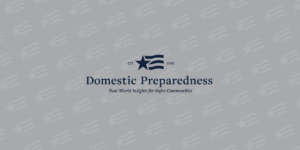

National Fire Academy Adds New Online Chemistry Course
Domestic Preparedness
May 24, 2012
The U.S. Fire Administration’s (USFA) National Fire Academy (NFA) announces the availability of a new NFA Online course: Foundational Concepts of Chemistry (Q228), which provides students with fundamental knowledge to prepare for the more advanced Hazardous Materials curriculum courses.

Finding Beds in the Middle of a Disaster
Beth McAteer
May 23, 2012
One of the most recent examples of medical surge in action was the response effort following a devastating EF5 tornado that ripped through the city of Joplin, Missouri, with virtually

A Healthcare Coalition’s Support for Evacuating a Facility
Craig DeAtley
May 23, 2012
As recent experiences have shown – the hospital evacuations in Joplin, Missouri, and Loma Linda, California, are perhaps the best examples – the partial or complete evacuation of a

Beyond Vaccines: Defeating Future Flu Viruses
David Gibson
May 16, 2012
Throughout history, invisible enemies such as plague, pandemic influenza, and other infectious
diseases have posed a great threat to human life. Public- and private-sector agencies and organizations
are diligently working together to prevent future pandemics before they start. The immediate goal is to
protect the nation’s warfighters, but the greatest beneficiaries may well be millions of civilians –
both current and future generations.

Mass-Fatality Surge & Family Assistance
Thomas Russo
May 16, 2012
The South Carolina Region’s healthcare coalition is bringing together various resources and knowledge to improve capabilities for mass-fatality incidents and subsequent family assistance operations. Through ongoing discussions, the coalition is able to address planning efforts – e.g., additional training and exercises, available morgue space, multi-jurisdiction cooperation, and various other aspects of fatality surge – that can be implemented and improved upon for years to come.

Amateur Radio and the Healthcare Field
Michael Corey
May 16, 2012
Amateur Radio can be a lifesaving communications service that has supported emergency responders,
law-enforcement teams, and the public during major flood events, power outages, hurricanes, earthquakes,
and other disasters both large and small. Like other “Guardian Angels,” the nation’s Amateur Radio
operators may not always be seen, but they are almost always there – wherever “there” is – when they are
most needed.

The 2012 PHP Summit: Sustaining Preparedness
Jack Herrmann
May 9, 2012
A “big-screen” presentation, an all-star panel discussion, the Joplin tornado, preparedness gains – and the many gaps that still remain – were among the major highlights of the 2012 Public Health Preparedness Summit in Anaheim. Numerous workshops and town hall meetings were also on the hugely important schedule. Plan early to attend the 2013 Summit in Atlanta, Georgia.

Taxis for the Sick
Joseph Cahill
May 9, 2012
Thanks to the increased focus on homeland security in recent years, most Americans now understand the need to “triage” victims of a mass-casualty incident. Less understood is the triage approach as it applies to taking patients from an incident site to a healthcare facility: (a) immediate transport, with medical care en route; (b) less urgent transport, with minimal medical care needed en route; and (c) non-urgent transport, emergency vehicles not necessary.

FINAL REPORT: Preparedness Goals Associated with the Nuclear Threat
Vayl S. Oxford
May 8, 2012
In 2011, the world witnessed the devastating effects after Mother Nature triggered an accidental “nuclear attack” on Japan. That incident offers a glimpse of what could happen following a deliberate nuclear attack on U.S. soil. On 2 May 2012, Vayl Oxford led a distinguished panel of experts in New York to discuss a very real threat that faces the nation. View results from the latest DomPrep survey and the final report that spurred this discussion as well as ongoing dialogue among attendees.

Mass Violence: Planning & Response Considerations Course
Domestic Preparedness
May 4, 2012
This is one-day course is designed to help prepare first responders and receivers to assess, plan for, prepare for, and handle critical incidents such as workplace violence attacks, school shootings, mass shootings, domestic violence spill-over attacks, extremist threats and other incidents are occurring with alarming frequency.

